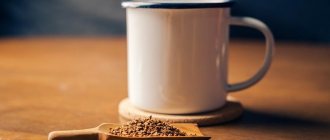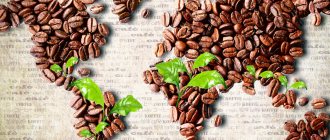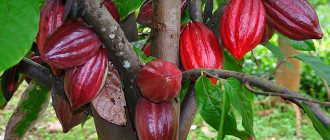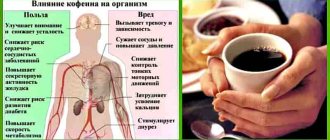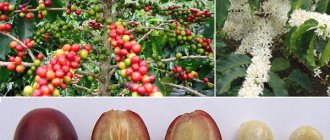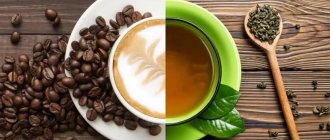Usually people do not doubt the presence of caffeine in coffee, considering it an integral element of the drink. Indeed, this alkaloid determines the well-known strength of the drink. It has no smell, but at high concentrations it gives the drink a noticeable bitterness. The amount of caffeine does not determine either the coffee aroma or the specific taste of the drink. Therefore, it is impossible to say for sure, based only on taste sensations, whether there is caffeine in instant coffee.
Its presence can be indirectly judged by the invigorating effect of drinking a cup of coffee. Caffeine has psychostimulant properties and has both positive and negative effects on the body. Therefore, along with regular instant coffee, manufacturers produce a decaffeinated version.
Caffeine formula
What is instant coffee
This concept hides a powdered, granulated and freeze-dried drink produced using a special technology from substandard Robusta beans, less often Arabica beans.
They are fried, crushed, poured with boiling water and undergo several more complex transformations before reaching the store counter.
Instant coffee always contains caffeine, even if the package is labeled as decaffeinated. The strictest American standards allow up to 3 mg of caffeine in one standard cup of drink. How does a drink made from instant powder differ from a natural one?
- Natural contains a large number of oils, which give it a rich aroma and taste. In soluble they are not present in their natural form due to the peculiarities of the technological process.
- Soluble contains many chemical additives from flavorings and flavor enhancers to artificial oils. This is done in order to bring its taste as close as possible to natural.
- The caffeine content in a cup of instant drink is an order of magnitude higher than in a cup of drink made from natural grains.
Freeze-dried coffee contains more useful substances than powdered coffee, as it is produced using freezing technology
Instant coffee gives a boost of energy by stopping the relaxation reactions that the nervous system sends to the entire body when it needs rest to recuperate. The effect is quick but short-lived and often leads to an even greater desire to rest or even fall asleep.
Are there any benefits from freeze-dried coffee?
Eat! Contrary to popular belief that instant coffee is useless, in fact this drink has a number of valuable qualities that are almost equal to the qualities of regular ground coffee.
The benefits of freeze-dried coffee
So, instant coffee:
- improves brain functions;
- increases metabolism (caffeine speeds up metabolism and helps burn more calories);
- reduces the risk of neurodegenerative diseases such as Alzheimer's and Parkinson's diseases;
- reduces the risk of type 2 diabetes;
- improves liver health, reducing the likelihood of cirrhosis and cancer;
- improves mental health, reducing the risk of depression and suicide;
- promotes longevity.
In addition, instant coffee, like regular coffee, reduces hunger, improves your mood, gives you a boost of energy and energy.
The dangers of freeze-dried coffee
The consumption of freeze-dried coffee (like any other) should be limited for people with heart disease, high blood pressure, diseases of the excretory systems, sleep and mental disorders. It is also not recommended to offer instant coffee to young children, and pregnant and breastfeeding women should reduce the amount of this drink in their menu. Doctors also do not advise drinking coffee on an empty stomach or in the afternoon.
How much caffeine is in a cup
It is impossible to answer the question with 100% accuracy. The content of the stimulating alkaloid depends on the type of bean, the amount of finished coffee in the cup and the volume of water.
On average, a 250 ml cup can contain from 45 to 100 mg. There is an opinion that the more expensive the drink, the more psychostimulating alkaloid it contains.
Which drink has more caffeine? Instant coffee contains more alkaloid than grain coffee. The difference can reach up to 40 mg. If we are talking about decaffeinated coffee, then the difference increases to 100 units compared to regular natural coffee. To be more precise, you can specify the amount in milligrams of the alkaloid caffeine in a teaspoon. So 3-4 g of soluble it contains about 50 mg, when ground it contains up to 35 mg.
The most energy in a cup of espresso
Robusta beans are inferior to Arabica in terms of caffeine content by about 20 percent, so when purchasing your next package, it doesn’t hurt to study all the information on it in order to navigate the taste and tonic properties of the drink.
What is coffee pods
For your information: in the CIS countries, the granulated drink has become very popular; 80% of the total number of coffee lovers buy it. Only 20% prefer natural.
In the West, these numbers have the opposite meaning and the question is not only about taste preferences, but about the fact that natural coffee is counterfeited much less frequently than instant coffee, and its quality is always higher and is checked more carefully.
Methods for Extracting Caffeine from Beans
The need for such technologies arose not only because coffee had to be made less strong and safer for human health. Caffeine is a valuable raw material for the pharmaceutical industry , which means it was necessary to learn how to extract this ingredient.
The pioneer laurels in this matter belong to the German entrepreneur Ludwig Rosemus. In 1903, he had to rack his brains over how to save coffee, a large batch of which was transported by sea and was not saved from the water during a storm. Studying the degree of suitability of the product, Rosemus came to an unexpected conclusion: the taste characteristics of the product were practically not affected, but the caffeine was clearly much less than that contained in natural coffee that was not damaged by the storm.
Having made this discovery, Rosemus continued his research, and soon created and patented his own method for producing the alkaloid. After that, he established the production of a caffeine-free product in the United States, giving it the name “Sanka” (translated from French “sans coffeine” means “caffeine-free”).
Today they have learned to extract caffeine in several ways, but each of them is based on what Ludwig Rosemus invented in his time, soaking. These are the methods:
- Swiss. It began to be used in 1979. The method is highly effective - 99.9% of caffeine can be extracted from beans; the method is environmentally friendly, but, unfortunately, expensive. The method is as follows: green coffee beans are kept in heated water, into which the alkaloids pass after some time. By passing water through charcoal filters, pure caffeine is obtained, and the liquid itself, which contains valuable oils, without which the drink risks becoming empty and tasteless, is returned to the original product and dried.
- Direct (or traditional) method. Its peculiarity is that the beans are first soaked in water and then in a special solvent, which speeds up the caffeine extraction process. This is followed by another treatment with water (boiling water) and drying. Ethyl acetate is used as a solvent in modern production, and previously preference was given to methylene chloride, but it turned out that this substance has a negative impact on the Earth’s ozone layer, so in 1995 restrictions were introduced on its use. However, neither one nor the other artificial solvent is ideal: it is not possible to completely wash them out of the grains, and this is the main disadvantage of the technological process.
- Indirect method. It is in many ways identical to the previous one, but consists of several processing cycles, thanks to which the beans retain their aroma and taste more fully.
- CO2 extraction. In this technology, water is present in a vapor state. After processing the grains with it, the raw material is transferred for 10 hours to a special chamber filled with carbon monoxide (CO2) under pressure. The gas releases caffeine from the beans while preserving valuable coffee oils. Another advantage of the method is that the final product is completely free of chemical impurities.
How to froth milk for cappuccino? The answer is in this article.
Read about the symptoms of coffee allergy in adults in this publication.
Dosage and overdose
In the West and in America, a single dose of coffee with a caffeine content of 80-100 mg is considered safe. That is, a cup consisting of 2 tablespoons of instant and 3 tablespoons of ground will not cause harm to health and will have a stimulating and tonic effect for the next 3 hours. The daily dosage of the alkaloid should not exceed 350-400 ml, that is, 3-4 cups.
Cigarettes and instant coffee are the main enemies of the cardiovascular system
For hypertensive patients, diabetics, people suffering from ulcers and gastritis, it is especially important to know whether there is caffeine in the drink they drink and what its content is. These categories of lovers of an invigorating drink usually experience a rapid heartbeat, a rise in blood pressure up to 10 units and abdominal pain after drinking a cup of their favorite drink. They are recommended to drink coffee that does not contain caffeine, but does not differ in taste from a regular drink.
How much can you drink? The dosage is small - 1-2 cups per day, since a small proportion of the alkaloid, which is unsafe for them, will still enter the body.
By adhering to the golden rule - “everything should be in moderation”, you can enjoy the most popular drink in the world every day and not harm your health.
Consumption standards
Today, everyone knows that the consumption of drinks that contain caffeine should be limited. The first reason is that the drug can cause addiction in humans. Second, for many diseases the use of an alkaloid is prohibited.
According to the conclusion made by Russian doctors during a special study, the norm for a healthy person is to consume caffeine in a dosage of 150 to 300 mg per day. This value can be divided into several cups or drunk at one time.
American scientists provide their statistics, where single use should not exceed 100 mg, and 3 doses per day are allowed. Freeze-dried coffee drink is not recommended to be consumed in unlimited quantities, despite the fact that it contains much less caffeine than natural coffee.
Recommended daily dose of caffeine
The 2015–2020 Dietary Guidelines for Americans indicate that adults should consume no more than 400 mg of caffeine per day.
There are no set strict rules for children, but the American Academy of Pediatrics FDAT discourages children and adolescents from consuming caffeine.
The authors of a 2022 systematic review suggest that adolescents aged 12–18 years consume less than 100 mg of caffeine per day.
They also warn that caffeine may have stronger effects on children under 12 because they tend to weigh less. The authors conclude that young children can tolerate an average of 2.5 mg of caffeine per kg of body weight.
Myth 5. The darker the granules, the stronger the taste.
The ideal color of coffee granules is light brown, the surface is glossy and shiny. In this case, the drink is made from medium-roasted beans and retains maximum antioxidant properties and rich taste.
High-quality and tasty coffee - in light granules (Photo: Pixabay.com)
The type of granules can only be assessed through glass packaging, which is why reputable manufacturers sell their product in transparent jars.
You should not buy coffee in plastic, tin, opaque containers. It will not please you with its taste, and the body will receive much less benefit than from a high-quality drink.
Then what kind of coffee should you drink?
We only get the caffeine effect from whole bean coffee. After this, we must be prepared for the onset of the theobromine phase - the opposite effect.
The theobromine stage occurs when drinking any type of coffee, no matter what quality.
Some varieties maintain the “caffeine stage” for up to 30 minutes. But then you still get the theobromine stage. Its duration is much longer, about 60-70 minutes.
Everyone can feel this for themselves. The phase of activation and surge of energy feels good, after which you want to relax a little.
Therefore, it is important to remember: by drinking plain water at the right time, the stage of the negative effect is reduced. You prevent deterioration of renal blood flow.
Therefore, now knowing the mechanism of action of coffee, make it a rule: always drink water after a cup of coffee. Your kidneys will thank you!
About the tonic
Caffeine (C8H10N4O2) is an alkaloid found in some plants, including the coffee tree. Plants produce a substance to protect against pests and for a more active pollination process.
Caffeine in coffee has a stimulating effect on human organs and systems:
- CNS;
- heart;
- blood vessels;
- regulates glucose levels.
During storage of beans (up to 7 years), the percentage of caffeine content does not change, but during roasting it increases.
Manufacturing technologies
The grains from which the instant drink is made undergo many processing processes: roasting, grinding, pouring boiling water, evaporating moisture. Fry the raw material for about 15 minutes; 2 hours are allocated for other processes.
There are two ways to get the drink: “spray dry” and “freeze dry”. The first grain is dehydrated by evaporation and the resulting extract is sprayed. This is how the powder is prepared.
Freeze dry technology is more modern; it involves the same production stages. But, at the final stage, the extract is frozen. It flows in a slow stream onto the drum, cooled to -60°. The particles envelop the mechanism as it rotates, the moisture is frozen out and the raw materials are sprayed in the form of small pyramids.
As a result of processing, the caffeine-containing product:
- contains less than 1/4 of the original raw materials;
- loses its natural properties;
- loses taste and aroma.
In order to make the powder more attractive to consumers, manufacturers add various additives (natural or artificial). This happens at the packaging stage.
Sometimes, during the production of an instant product, manufacturers use coffee berry shells, so the percentage of glucose in the finished drink increases. Only the pulp contains natural sugars.
In order for instant coffee to have the characteristic aroma of the drink, the product is enriched with coffee oils. Essential oils are obtained between the process of frying raw materials and brewing with boiling water. The aroma is collected, liquefied and returned to the future drink. The amount of essential oil is small, but it is enough to produce the aroma. Oil is also added during packaging.
There is another technology. Its essence lies in the introduction of microscopic particles of fried ground grain into the granule of a soluble product. The percentage of caffeine in such instant coffee increases, and a more expressive taste also appears.
Effect of caffeine on the body
Caffeine is synthesized in plants specifically to protect it from being eaten by insects and animals. This substance is a good stimulant of the human nervous system.
When consuming caffeine, blood pressure increases, the pupils become wider, attention and intelligence increase, endurance increases, and the pulse accelerates. At the same time, caffeine blocks some enzymes and promotes the rapid breakdown of fats. Thanks to these properties, with constant consumption of coffee or, for example, Chinese green tea, people tend to lose weight and have greater stamina.
Where else is the invigorating element found?
Chocolate treats
Not only coffee drinks have a tonic effect. There is caffeine in hot chocolate or cocoa.
1 serving of hot chocolate from a bag contains 5 mg of the substance. In a standard serving of chocolate milk, the level reaches 8 mg.
Carbonated
Coca-Cola, which even small children drink, also contains a tonic element.
In regular Cola it is 40 mg per 0.35 liter can, and in diet Cola the figure rises to 50 mg.
In Pepsi, the amount of the substance reaches 38 mg per 0.35 liter. In Mountain Dew - 50 mg for the same volume of the can.
The record holders for alkaloid content are energy drinks. Any energy drink contains at least 30 mg per 0.33 liter jar. The indicator can reach 90 mg.
Are you a coffee lover?
Not only coffee beans, but also cocoa beans and even tea leaves contain caffeine. And there is even much more of it in tea, but in one cup the concentration of the alkaloid will be less.
How do you know if you are addicted to coffee? First, you need to give up the habit of drinking this invigorating drink and observe how your body reacts. If you previously drank at least 5 cups a day, then after a couple of days you will begin to suffer from a headache that will be localized in the occipital region.
Then irritability and short temper will appear. Often, appetite disappears completely or is significantly reduced. Uncomfortable sensations appear in the muscles. At the psycho-emotional level, a person adjusts himself to the fact that without caffeine he cannot cheer himself up. After one month of quitting coffee, you will feel better and are unlikely to want to become addicted to this drink again.
Attention: how to drink coffee correctly
You drank a cup of coffee. After 20 minutes, drink a glass of water . Exactly like that and in that sequence.
Thus, prevent the phase of impaired water-salt metabolism: do not allow the kidneys to fall into a state of impaired blood flow. Live and learn.
There is only one “but”: all of the above applies to bean coffee.
Myth 4. There is no difference between what is in powder and what is in granules.
If you choose a quality drink, pay attention to freeze-dried coffee. Sublimation technology allows you to preserve the entire volume of beneficial substances present in coffee beans. Production using this technology is more expensive than other methods, so it is used for premium drinks. Powdered coffee is the cheapest and least quality.
Three-in-one drinks have nothing to do with classic coffee. They are high in sugar and contain added milk powder and palm fat. They are high in calories, increase cholesterol levels and “bind” caffeine. It turns out sweet, tasty, but very harmful.
